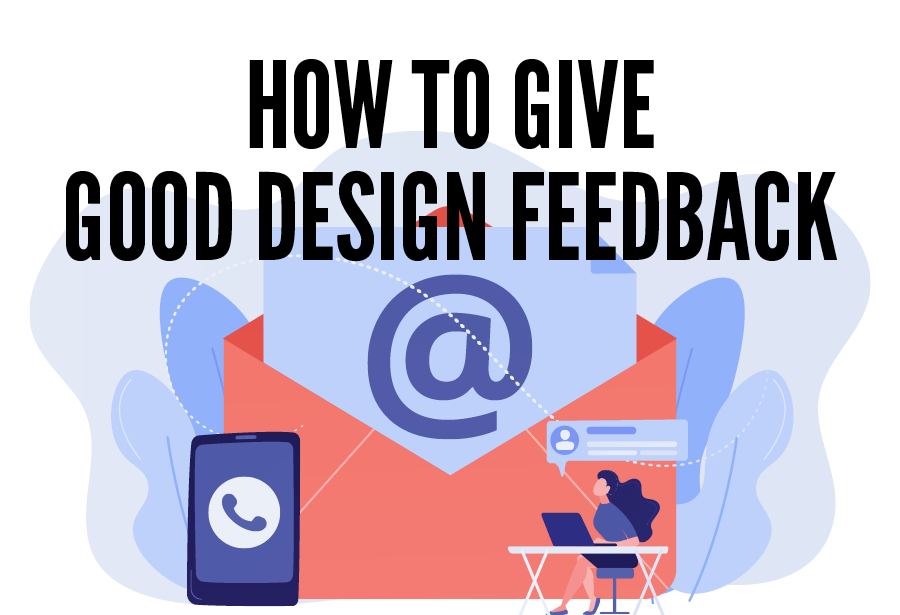Getting feedback is an integral part of the design process. On rare occasions, the unicorn project comes along where I show a design and it’s approved immediately with no edits, but most of the time there are at least some (hopefully minor) edits to make. Giving good feedback is a learned skill (as is receiving it, but that’s another story). I’ve worked with a lot of people over the years with varying communication styles, and the best feedback-givers have a few things in common.
The best feedback is:
- Clear and specific. Vague feedback is THE WORST. Statements like ”I’m not feeling it”, “make it pop”, or “it needs more pizazz” are difficult to discern…I’m not sure what I think pizazz is myself, so I definitely don’t know what that means to anyone else. Helpful feedback is specific and clear: change a color or a font, find a new photo, make something bigger, or move a graphic over there to make it the focus. But I can’t make a design “pop” or “feel right” to you unless I know more specifically what you mean by it.
- Timely. In order to keep things moving and on schedule, feedback should be provided in a timely manner. The actual turnaround time will vary depending on schedules and the number of people involved, but the longer it takes to get feedback, the more momentum and focus we lose.
- Mindful of the overall goals. Keeping the overall project goals in mind gives us some guardrails and helps keep us focused on what is best for the project rather than our own personal likes and dislikes. Ideally, there’s a reason why we’ll make changes…swapping a photo with one that will engage the audience is a much better reason for the change than the client disliking something for personal reasons.
- Given in the most appropriate format. General feedback about overall concepts is fine for the phone, but specific edits are best given in writing. If I’m working on a printed newsletter or report, I want to get more specific design edits (move this here, resize this, etc.) and all text edits in writing—either an email or a marked up PDF is great. That way, I can make the edits, and then have my proofreader go through them again to confirm that I caught them all. Whenever a client wants to give me text edits via phone, I always make sure they know that the margin for error is a lot higher and that I can’t check my work that way.
- Candid and constructive (but not rude). Good feedback is honest and candid—I want to know what you really think, so that the final product is something that solves the challenge at hand and makes you feel good. But feedback should also be constructive and respectful. It may take a few rounds of feedback for us to get on the same wavelength. And even if we disagree on how to arrive at the best design solution, we’ll get there much faster if we play nice and work together. Also see #6.
- Objective. Design is subjective, on all sides. There are any number of reasons why I designed something the way I did, and any number of reasons why you might like or dislike it. The focus of all feedback, always, should be on the work itself, not on the designer—refrain from using personal pronouns. “I think this needs more whitespace” is much better than “You made everything too big and crowded”; it separates the work from the designer and keeps the critique on the design. After all, it’s not about me.
- Consolidated. I once worked on an annual report for a law school, and things were humming along great until the final review—my client hadn’t shared the design with any of the Board Members on the team, and they wanted to go in a completely different direction. We were able to pivot and salvage a lot of the work we had already done, but the end result was delayed and more frantic than it should have been. I’ve also been in situations where I get contradicting notes from different team members, and then have to spend time figuring out whose directions to follow. Feedback should be given by a single point of contact after getting consensus from the team. And ideally the team is as small as possible to keep things focused.
- Focused on communicating problems, not solutions. I want to hear what isn’t working and why, and if you have thoughts on a possible solution, I’m all ears. But I have experience and may know what will or won’t work, and I want to be able to arrive at your destination on my own rather than just taking orders.
Other good feedback to keep your project humming along
It sounds simple, but sharing a design budget has a huge impact on the success of your project. Yet it’s one of the most difficult topics for people to discuss. Even if something comes up in the middle of a project, be sure to share the financial implications with your graphic designer. She can probably figure out some alternatives to keep the project moving forward, or at least a plan for picking back up when you’re ready and able.
